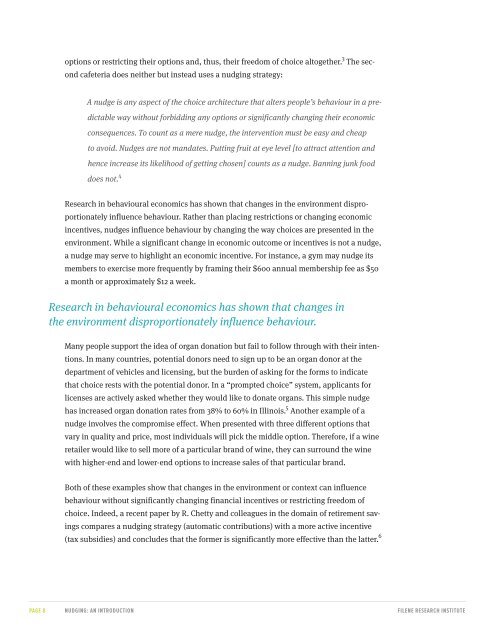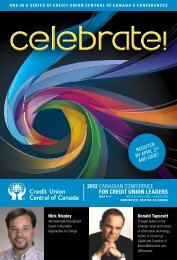A Practitioner’s Guide to Nudging
A Practitioner's Guide to Nudging - Credit Union Central of Canada
A Practitioner's Guide to Nudging - Credit Union Central of Canada
- No tags were found...
You also want an ePaper? Increase the reach of your titles
YUMPU automatically turns print PDFs into web optimized ePapers that Google loves.
options or restricting their options and, thus, their freedom of choice al<strong>to</strong>gether. 3 The second<br />
cafeteria does neither but instead uses a nudging strategy:<br />
A nudge is any aspect of the choice architecture that alters people’s behaviour in a predictable<br />
way without forbidding any options or significantly changing their economic<br />
consequences. To count as a mere nudge, the intervention must be easy and cheap<br />
<strong>to</strong> avoid. Nudges are not mandates. Putting fruit at eye level [<strong>to</strong> attract attention and<br />
hence increase its likelihood of getting chosen] counts as a nudge. Banning junk food<br />
does not. 4<br />
Research in behavioural economics has shown that changes in the environment disproportionately<br />
influence behaviour. Rather than placing restrictions or changing economic<br />
incentives, nudges influence behaviour by changing the way choices are presented in the<br />
environment. While a significant change in economic outcome or incentives is not a nudge,<br />
a nudge may serve <strong>to</strong> highlight an economic incentive. For instance, a gym may nudge its<br />
members <strong>to</strong> exercise more frequently by framing their $600 annual membership fee as $50<br />
a month or approximately $12 a week.<br />
Research in behavioural economics has shown that changes in<br />
the environment disproportionately influence behaviour.<br />
Many people support the idea of organ donation but fail <strong>to</strong> follow through with their intentions.<br />
In many countries, potential donors need <strong>to</strong> sign up <strong>to</strong> be an organ donor at the<br />
department of vehicles and licensing, but the burden of asking for the forms <strong>to</strong> indicate<br />
that choice rests with the potential donor. In a “prompted choice” system, applicants for<br />
licenses are actively asked whether they would like <strong>to</strong> donate organs. This simple nudge<br />
has increased organ donation rates from 38% <strong>to</strong> 60% in Illinois. 5 Another example of a<br />
nudge involves the compromise effect. When presented with three different options that<br />
vary in quality and price, most individuals will pick the middle option. Therefore, if a wine<br />
retailer would like <strong>to</strong> sell more of a particular brand of wine, they can surround the wine<br />
with higher-end and lower-end options <strong>to</strong> increase sales of that particular brand.<br />
Both of these examples show that changes in the environment or context can influence<br />
behaviour without significantly changing financial incentives or restricting freedom of<br />
choice. Indeed, a recent paper by R. Chetty and colleagues in the domain of retirement savings<br />
compares a nudging strategy (au<strong>to</strong>matic contributions) with a more active incentive<br />
(tax subsidies) and concludes that the former is significantly more effective than the latter. 6<br />
PAGE 8 NUDGING: AN INTRODUCTION FILENE RESEARCH INSTITUTE



